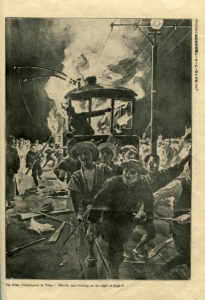Throughout the 19th century, Asia became home to the unrelenting forces of globalisation. Across Asia, anti-foreign violence and exclusionary policies like the Canton system separated the lives of Chinese and foreigners in virtually all areas but commerce. After imperial powers had gained extensive influence in China, foreign entities instituted their own policies of exclusion by regulating space to keep out natives and preserve their imposed dominance in the colonies. Despite the increased contact between Asia and the West throughout the 19th century, spatial arrangements strictly demarcated what was native space and what was foreign space.
In Qing-era China, the Canton system was the pinnacle of isolationist and exclusionary policy. However, preventing foreign entities access to the colossal commercial potential of the Chinese hinterland proved ineffective as British merchants still found ways to smuggle opium into various Chinese port cities. When the Chinese population became inundated with the adverse effects of the drug, the Qing imperial government attempted to crack down on foreign trade and the British responded with force, resulting in the First Opium War and the establishment of the Treaty Port system.[1] Efforts to stifle the spread of Western imperialism failed and the country was opened to the influence of imperial powers and international trade. Paradoxically, once Western imperial powers were able to open China to outside influence, they sought their own ways to limit cross-cultural contact. The British colonial government in Hong Kong provided one of the most potent examples of this through their manipulation of aesthetic and spatial arrangements in an effort to segregate the colony between the coloniser and the native.
The art historians Alex Bremmer and David Lung discuss the British policies of segregation in Hong Kong’s residential districts in the late 19th century. They assert that by creating areas that excluded native Chinese, the British residing in Hong Kong attempted to create what they deemed as an “orderly, civilised, visually coherent, and identifiable urban environment that reinforced the identity and interests of the dominant cultural minority.”[2] By the 1880s, Chinese outnumbered foreigners in Hong Kong by fourteen to one. As foreigners made up an increasingly small part of Hong Kong’s population, the colonial government sought to concretely demarcate which spaces were for foreigners and which were for Chinese. The ethnic homogeny of residential areas was of particular concern to the colonial government. Europeans generally held the belief that the Chinese population had unsanitary habits and would spread disease.[3] Apart from this overt racism, segregation was justified using the fear of a Chinese-driven mutiny on the colony. The Arrow War between 1856 and 1860 deepened resentment for the British in Hong Kong and the Qing government encouraged Chinese citizens in the colony to turn against the foreigners. In 1904, a bill was passed that formally reserved the peak area of Hong Kong for anyone who was “non-Chinese.”[4] The policy lasted until 1946.
Exclusion and segregation upon ethnic lines were ubiquitous in spatial arrangements between imperial China and foreign entities. The Canton system limited foreign commerce to a closed area and resulted in the opening of China by force in the First Opium War. As Bremmer and Lung show, colonial officials in Hong Kong made concerted efforts to separate themselves from the Chinese population, using racist arguments as well as the possible threat of violence against foreigners. No matter how strong their commercial ties were, the exclusionary spatial arrangements between Britain and China showed that ethnic tension and animosity persisted in significant ways leading into the 20th century.
[1] Spence, J. The Search for Modern China. Third Edition, (2013).
[2] Bremner, G Alex, and David P Y Lung. “Spaces of Exclusion: The Significance of Cultural Identity in the Formation of European Residential Districts in British Hong Kong, 1877–1904.” Environment and Planning D: Society and Space 21, no. 2 (April 2003): 246.
[3] Ibid
[4] Ibid
